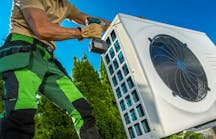Occasionally, “comfort” can be misunderstood to be a lifestyle perk that’s only available to a chosen few. But the reality is that quality home and building comfort, through the application of well-chosen and properly-installed HVAC systems, is available to all.
Laurel Schwartz spent a vast amount of time conducting research on solar installers and conducting in-person interviews.
“Everyone was passionate and dedicated to the cause of making the world a greener place, and everyone knew their craft,” she says. The decision came down to price point and their confidence in the contractor.
The solar company was a family company, which was in their favor. The solar payback they laid out was favorable, however there was still the issue of paying very high prices for fuel oil.
Climate Partners won the project based on a strong recommendation by the solar company.
The Schwartzes told Casey they were looking for a fully integrated solution, one that would incorporate solar-photovoltaics to power everything within the relative capacity of their yet-to-be-installed PV array, which was later installed by the solar company.
The assignment for Climate Partners: engineer a fuel-oil boiler conversion to a inverter hydronic heat pump with solar thermal water heating.
The system uses hydronic heat pump inverter technology integrated with both solar-PV for electricity and solar thermal for water heating, converting a previously fossil-fuel dependent energy hog home, into a nearly net-zero home, that is sustainable now, as well as for the next generation.
Casey had used the Daikin Altherma inverter heat pump for another project, and went with it again for this installation.
He also selected a Daikin variable speed hydronic air handling unit; Daikin hydro box; a Daikin 80-gallon dual heat exchanger indirect water heater; and a Caleffi dual-panel solar thermal kit. The hydro box heats the water that circulates through low temperature radiators, floor heating systems or fan coil units, and also provides domestic hot water.
“Daikin Altherma is a perfect solution when combined with solar-PV. It harnesses the renewable energy to heat, cool, and produce hot water from a single platform,” Casey says. “Its controls and programming are fully integrated already. It’s also a conventional system in the sense that our install team can implement the solution in-house, without the sub-contractors sometimes necessary for other similar systems, such as geothermal.” Those advantages can save time when other things crop up.
“Our design had to accommodate adding a completely new duct system to heat and cool from overhead to eliminate the baseboards,” Casey relates. “Particular attention had to be paid to how we would physically coordinate the placement of the new systems, while temporarily leaving the existing in place while we put everything into position, without compromising the final product/system.
“We also had to fully implement the system while the family lived in the home, without disrupting the daily family routine.”
“We implemented a fully-integrated, renewable system, including central heating, cooling, and water heating, powered by solar-PV and complimented by solar thermal water heat production, all with modulating capabilities, to accommodate and match the needs of the homeowners,” Casey explains.
The solar company managed the installation of the PV array, while Climate Partners took charge of installing solar thermal panels for hot water.
PRODUCT KEYS TO SUCCESS:
• Daikin Altherma ERLQ inverter heat pump
• Daikin variable speed hydronic air handler
• Daikin hydro box
• Daikin 80-gal. dual heat exchanger indirect water heater with solar
thermal kit
• Caleffi two-panel solar thermal system
• Honeywell WiFi
• Apco UV air purification system.
• Elite Software Rhvac for load modeling
• Installed according to performance standards established by ACCA and Building Performance Institute (BPI)
Installation Team:
• Tom Casey, chief quality officer
• Carl Synder, piping and solar
• Rich Papcun, ductwork
• Randy Kaluzynski, energy conservation
Casey is confident of this solar unit’s stamina and ability to provide sufficient energy.
“Our solar energy production in the northern half of the country is more prevalent in the summer. Today (a day in mid-June) the panels were at 140F. With solar thermal, you let the tank heat up as hot as it can get, up to 150, 175, or 180F. Then, we have a tempering valve for controlling the water out to the house,” he explains.
“The water is heated by solar thermal fluid circulating through one heat exchanger, when the solar thermal panels are hotter than the water in the tank. Altherma heats water in the hydro box, which is able to circulate through a second heat exchanger to heat water if needed. Plus, there’s a back-up electric element in the Altherma water tank in the event that either needs a boost to meet demands,” he continues. “Actual water temperature to the home is controlled by a tempering valve to deliver consistent temperatures in any of the three modes.”
Following start up and commissioning, the team disconnected and removed the existing boiler, controls, and dual oil tanks, to make the property completely fossil-fuel-free. All was accomplished while the homeowners lived in the home.
Sealed Right for Energy, IAQ
Ductwork was sealed, then insulated to minimize losses and improve indoor air quality. The home envelope was evaluated using a blower door, and then air-sealed to reduce heat losses in attic bypasses, basement areas, sill/rim joists. The integrated system qualified for Federal Tax Renewable Energy Credit.
Finally, they installed a Honeywell Wifi thermostat with circulation mode, plus an Apco UV air purification system.
System loads were modeled using Elite Software’s Rhvac, based on ACCA Manual J 8th Edition. Home performance measures were all implemented in accordance with BPI Building Analyst and Envelope standards.
“We had been $6,000 per year on energy costs,” Laurel Schwartz says. “This was after we closed off a zone of our house and kept the heat down to 58F in the evening, and not much past 68F during the day. But even after a very bad winter, we’ve paid only $1,200 for the first year. For now, that $4,800 savings has been used to finance their daughters’ college expenses.
“For us, this was as much a calculated financial move as it was about doing well for the environment,” she says.
And, she had nothing but great compliments for Tom Casey and his team.
“They were very comfortable to work with,” she says.
The Schwartz residential project combined cutting-edge technology with integrated renewables, to convert a previously fossil-fuel dependent home into a nearly net-zero energy home. Solar PV and solar thermal power drive the home’s core heating, cooling, and water heating systems, as well as ancillary electrical needs.
“This is particularly crucial to accomplish the family’s long term goals of providing a sustainable family home. Integrating many substantial, integrated systems in an occupied environment, without disrupting a family’s lifestyle required precise coordination, planning, and execution,” Casey says.
Tom Casey and his team for this project took an old fuel-oil, energy hog home with window units, and turned it into a super efficient, renewable energy home. And as many other homeowners are seeking energy-efficient comfort, Casey believes this project proves that renewable energy comfort products and solutions are not just for wealthy homeowners.
“Average families can realize their dreams and goals, too,” he says. We concur, and say, “Congratulations, Climate Partners, for winning another Quality Home Comfort Award.”
















